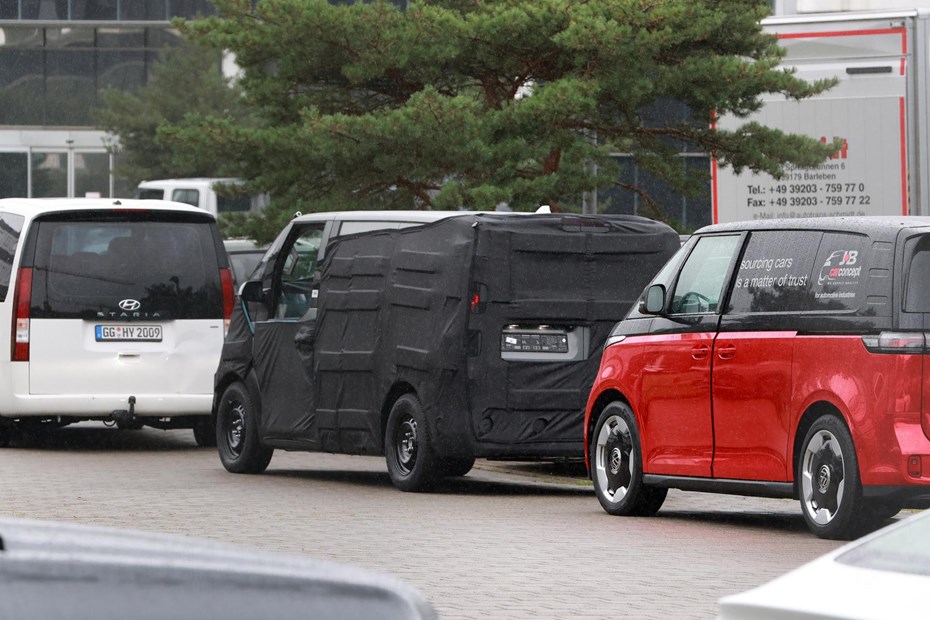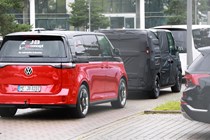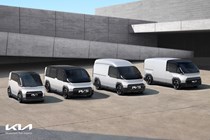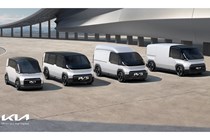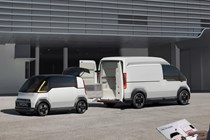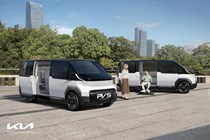The first of the Kia electric vans have appeared on public roads, albeit in heavily disguised form. Our photographers have caught the new PV5 testing alongside two likely competitors.
The PV5 small van is the first of the brand’s vans that are planned to go on sale in Europe, with it due to arrive in early 2026. Global production will start at the end of 2025 to make this possible.
The vans were first revealed at the tech show CES in Las Vegas in January 2024 where it was clear that Kia has decided to hit the ground running with its commercial vehicle range, revealing concept versions of three different vehicles in multiple configurations.
The PV5 doesn’t quite fit into the small or medium van category, being slightly larger than a classic small van. This would explain why it has been spotted testing alongside the Volkswagen ID.Buzz Cargo, which is another van that sits between the traditional classes.

The PV5 was also spotted alongside a Hyundai Staria, which is a similar-sized vehicle from Kia’s partner company, albeit one that is in no way related to the commercial vehicle
What PBV vans are planned?
The three different models are dubbed PV1, PV5 and PV7, with their respective sizes covering off two of the smaller major van sizes in the UK. However, there are more models planned, with a PV3 already designed, if not yet revealed.
The PV7 will follow shortly after the PV5, with Kia confirming at its 2024 Investor Day that the plan is for it to be on sale in 2027.
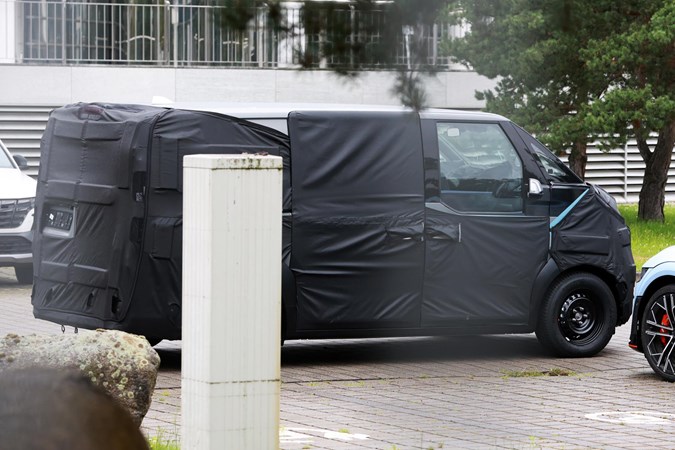
Kia has previously outlined its rollout plans for the new model range, saying that there will be three distinct launch phases, with different vehicles arriving at varied times.
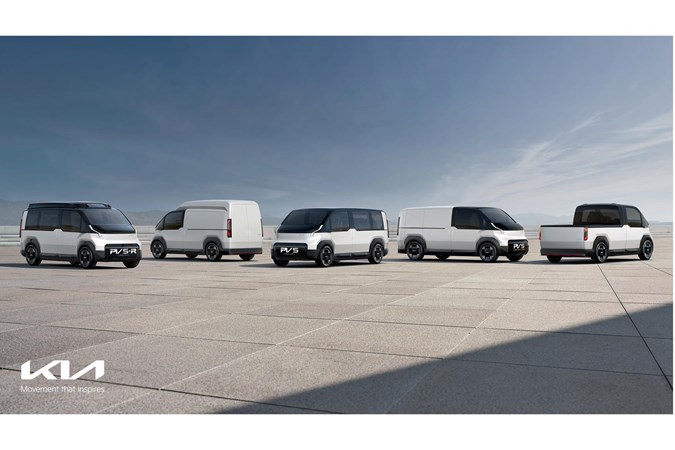
The brand is referring to the van plan as the PBV, or Platform Beyond Vehicle, strategy. This business and marketing terminology refers to the overarching thinking, the actual vehicles are vans and pickup trucks rather than anything else, and that’s exactly what Kia UK is likely to refer to them as when they go on sale over here, and indeed what we will call them.
What is not uncertain, though, is the scale of Kia’s ambition. It is aiming to hit global sales of 250,000 electric vans by 2030, with the PV5 making up 150,000 of these and the PV7 accounting for the remaining 100,000. These will be spread across a variety of customer sectors, including businesses and private buyers, working across delivery, utility and people-moving sectors.
What vehicles is Kia planning to launch?
The PBV, or van, range will kick off with the mid-size model of those shown, the PV5. However, this is not a classic medium-sized van , and Kia is targeting small-van rivals such as the Citroen Berlingo and Renault Kangoo. At around 4.7m long, it is about the same size as a long-wheelbase Berlingo, but Kia reckons it will be able to offer more space inside.
The standard panel van version will offer around 20% more interior space than its rivals, says Kia, with space for two Euro pallets. Payload has not yet been confirmed, but Kia is aware of the importance of being competitive with the Berlingo, which can take up to 1,000kg in electric form.
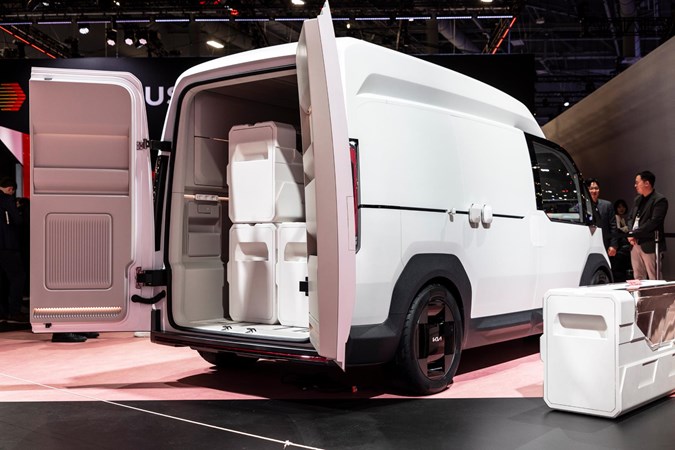
There will be multiple models alongside the standard panel van, including a high roof version, which is something the small-van rivals don’t offer at the moment. There will also be a people-carrying model with highly flexible seats and a self-driving Robotaxi, created by Motional, a joint venture between Hyundai Motor Group and Activ, in markets where it is possible. This means it won’t come to the UK any time soon though.
Kia has also shown images of a pickup conversion, although this remains something that is an exploration of the sort of things that are possible on the flexible platform that underpins the PV5.
The height and design of the PV5 means that you will be able to stand up in various shapes of the vehicle. Passengers will be able to stand up in the back of the people carrying model, while the driver of the high-roofed van will be able to walk through from the cabin to the loading bay.
There are expected to be three battery sizes in the PV5, with the goal being for the largest van to manage above 400km (249 miles) between charges.
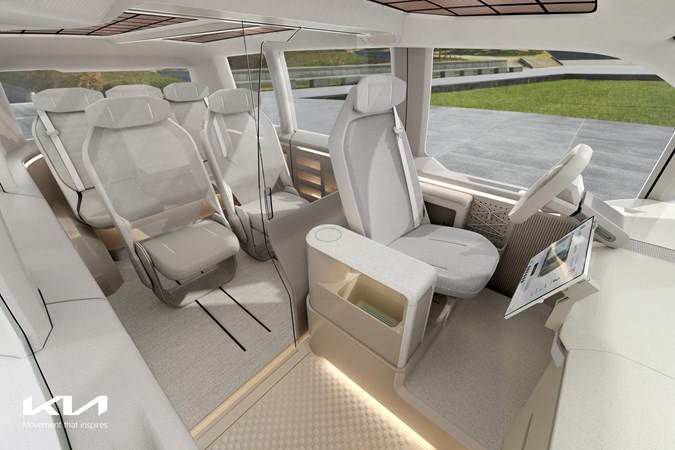
The PV5 is planned for phase one of the launch plan, with these sitting alongside a conventional panel van. Phase one will also see the launch of some of the above conversions based on the PV5 platform as well as the software behind the vehicle that is designed to aid fleet managers.
What about the other van categories?
The PV7 is set to be the second major model to launch, with Kia still aiming for on-sale date of 2027. It is a slightly larger van that is aimed at the medium-van category. This means taking on the likes of the Vauxhall Vivaro and Ford Transit Custom.
The longest PV7 is around 5.7m, which is longer than the biggest model of both the Transit Custom and the Vivaro. At the moment, though, Kia has only shown one length and height of the PV7, but different sizes are possible and could be added to the range later.
There is very information on the battery capacity of the PV7. However, Kia has said that the PV7 is ‘defined by more space, greater distance, and enhanced functionalities,’ which suggests that it might have a larger-battery model with a long-range ability.
Phase two could also see the arrival of the PV1. This is a much smaller vehicle that is around the same sort of size as a Citroen Ami, and it is targeting the same sort of last-mile delivery market. However, it is a very different prospect as the PV1 is a driverless vehicle, that is designed to set off and deliver on its own. Suffice to say it probably won’t heading to the open market in the UK any time soon therefore.

Kia also says the third phase will bring more personalisation, increased autonomous driving abilities and ‘swappable solutions.’ More on what that means as we get closer to the time, no doubt.
Customer feedback
Kia is going full in on its new PBVs/vans and is planning to launch a full business system around the vehicles to support customers and to drive future development.
It says that it will be able to create conversions in house, rather than having to send customers out to third-party companies to get their van tailored to their specific needs. It will also integrate data and AI tech to develop in-vehicle infotainment, fleet management and charging solutions.
Will these vans be coming to the UK?
That is the plan, yes. The UK team is prepping for the Kia electric vans to arrive and they are having discussions with dealers and elsewhere in the network. One thing is for sure, though – the ‘PBV’ name won’t be front and centre over here, as they will be referred to as eLCVs instead, or simply electric vans.
The earliest any of them will come is 2026, but we’ll bring more information on pricing, launch dates and technical details when we have them.
Just so you know, we may receive a commission or other compensation from the links on this website - read why you should trust us.


